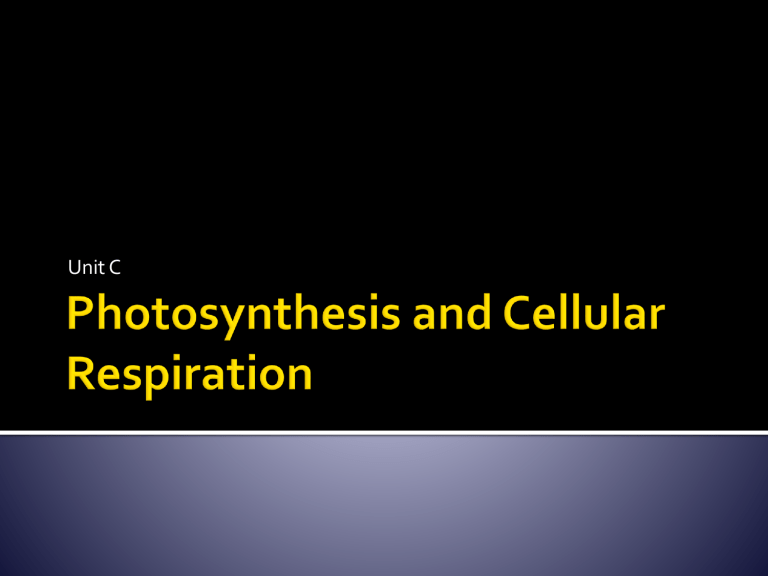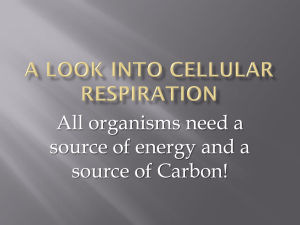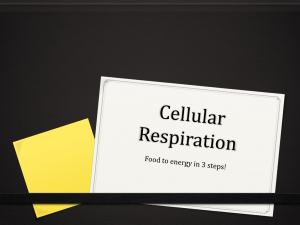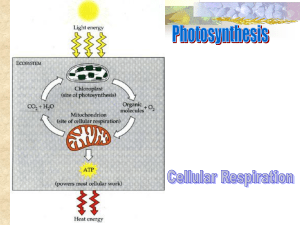Photosynthesis and Cellular Respiration

Unit C
Energy arrives from the sun and is captured by green photosynthetic plants and stored as glucose
Non photosynthetic organisms must obtain energy by breakdown of energy rich stores
Photosynthesis=capturing and converting light energy from the sun
Cellular respiration=releasing stored energy for life proccesses
Sunlight (energy in)
CO
2 and H
2
O released from the heterotrophs when they breath etc and taken in by the autotrophs
Photosynthesis
(autotrophs)
Glucose stored in plant cells and eaten by heterotophs
Oxygen released into air and breathed in by heterotrophs
Cellular Respiration
(heterotrophs)
ATP (energy out) used by the organism
For life proccesses
Cellular Respiration
MITOCHONDIRA
Pg 176-177 Are you ready
Pg 178-187
CO
2 (g)
+ H
2
O
(l)
+ energy C
6
H
12
O
6(s)
+ O
Carbon dioxide and water and energy produce glucose and oxygen
2 (g)
Captured light energy is converted into chemical energy
Series of complex reactions that form a
variety of intermediate and final energy rich molecules
Occurs in green plants, algae, protists, cyanobacteria because they all contain green colour pigment chlorophyll
Chlorophyll
Absorbs photons of solar light with wavelength between 500nm and 600nm which we see as green
Type a- blue green, primary light absorber
Type b-yellow green, accessory pigment
Summer/spring plants green b/c of increase in chlorophyll, winter/fall plants are red, yellow, brown
Contained in cholorplasts
Chloroplasts pg 183
Only in leave, stems and un-ripened fruit
Energy Rich molecules formed during photosynthesis
(pg186)
ATP-adenosine triphosphate
NADPH-nicotinamide dinucleotide phosphate
Glucose
A.
B.
-
Light dependent reactions occurs in the thylakoid membrane and requires chlorophyll
Light energy turns into chemical energy (stored as ATP)
Light independent reactions a.k.a. Calvin
Cycle, Carbon Fixation
occurs in the stroma
- Uses ATP from light dependent reactions to produce glucose
Electron Transport Chain pg 188
A series of steps in which many small reactions happen
If all energy was taken or given at once it would kill the cell
Electrons are high energy particles present in atoms that get ‘excited’ by light energy therefore have chemcial energy
Pholoysis is the process of releasing electrons from water compound
Oxidation/Reduction Reactions
Atoms/molecules gain or lose electrons to gain or lose energy
Oxidation= electron donor=lose electrons therefore gain energy
Reduction= electron acceptor=gain electrons therefore lose energy
LEO goes GER e.g. NADPH loses H+ and 2 electrons and converts to
NADP+ and absorbs energy e.g. NADP+ gains H+ and 2 electrons and converts to
NADPH and energy is released
Photo systems I and II are the clusters of chlorophyll embedded in thylakoid membrane
Light “splits” (photolysis) H2O in photo system II,
oxygen gas is released
H+ ions remain inside the thylakoid
excited electrons get passed along via the electron transport chain
A.
B.
C.
D.
Electrons from photosystem II are transferred along an ETC and through thylakoid membrane
Some energy released at each “step” pulls H+ ions across the membrance, resulting in a positive charge within the thylakoid
By the time the electrons reach photosystem I they have to “recharge” in a chlorophyll molecule
Newly excited electron from photosystem I releases energy so that NADP+ can be made into NADPH (for use in Calvin Cycle)
Remember the build up of H+ ions inside the thylakoid…
H+ ions now get rushed through the ATP synthase complex
They release energy that is used to turn ADP and
Pi into ATP (process called chemiosmosis)
ATP is off to the Calvin Cycle
SIMPLIFIED
ATP, NADPH, CO2 and H+ ions from light dependent reactions make G3P in a series of cyclical reactions
For every 1 CO2 molecule you will get 3 ATP and 2
NADPH
To get on C6H12O6 molecule you will need 18 ATP
12 NADPH and 6 H2O
Pg 202-209, 213-214
C
6
H
12
O
6(s)
+ O
2 (g)
CO
2 (g)
+ H
2
O
(l)
+ energy
Glucose and oxygen produce carbon dioxide and water and energy
Process used to release energy needed for all kinds of cellular work
Series of complex & intermediate stages and
molecules, converting glucose into useable form of energy (ATP)
36% efficient (36% into ATP v.s. 64% thermal)
Mitochondria
Round sausage shaped organelles scattered through cells cytoplasm
Specialized in production of ATP
Energy Rich molecules formed during cellular respiration
ATP
High energy compound
Motion, transport or ions/molecules, building molecules, switching reactions on/off, bioluminescence (pg 206)
Glucose
More energy rich than ATP
Not easily used for energy
Through a series of oxidation-reduction reactions electron carrier molecules transfer electrons (lose and gain) and release useable energy to be used in the process
NADH and NAD+,
FADH
2 and FAD
2
+
#1 Aerobic
Takes place in presence of oxygen
36 ATP produced per 1 glucose
4 stages a. glycolysis b. pyruvate oxidation c. kreb cycle d. electron transport and chemosmosis
#2 Anaerobic
Takes place when there is a lack of oxygen so glucose is not completely oxidized
2 ATP produced per 1 glucose
2 stages a. glycolysis b. fermenation
Stages of aerobic respiration are all linked to one another
Occurs in the cytoplasm of the cell as well as inside the mitochondria
Theoretical yield= 36 ATP but in numerous experiments under normal conditions only about 30 ATP are produced
Sugar splitting
Occurs in cytoplasm of cell
One glucose (6 carbon)converted into two pyruvate (3 carbon)
Does not require oxygen
Two ATP used and four ATP produced so net
ATP production is two
TOTAL Reactants TOTAL Products
Glucose (6 carbon) 2 pyruvate (3 carbon)
2 NAD+ 2 NADH
2 ATP 2 ADP + Pi
4 ADP + Pi 4 ATP
Net total of 2 ATP not enough to be only source of ATP
22% efficient
1 glucose + 2 ADP + 2 Pi + 2NAD + 2 pyruvate + 4 ATP + 2 NADH + 2 H +
Pathway that connects glycolysis to Kreb’s cycle
Occurs in the matrix of the mitochondrion
Pyruvate (3 carbon) is used to make a molecule called acetyl Coenzyme A (2 carbon)
Carbon dioxide is released as waste
NAD+ is reduced to NADH
TOTAL Reactants TOTAL Products
2 pyruvate 2 Acetyl CoA
Co A CO2
2 NAD+ 2 NADH
Net Total of 2 NADH that head to the Krebs cycle no ATP produced here
2 pyruvate + 2 CoA 2 acetyl CoA + 2 NADH + 2CO2
Most complicated made up of 8 reactions that are catalyzed by separate enzymes
Cyclical process which means that the products produced in step 8 are the reactants for step 1
Each pyruvate molecule enters the cycle separately meaning it happens twice for every one glucose
Acetyl CoA enters the cycle and the CoA is released and goes back to stage 2
TOTAL Reactants TOTAL Products
2 Acetyl CoA 4 CO2
6 NAD 6 NADH
2 ADP + Pi
2 FAD
2ATP
2 FADH2
Reminder the following are coming to ETC
2 NADH (glycloysis)
2 NADH (pyruvate oxidation)
6 NADH (Krebs cycle)
2 FADH2 (Krebs cycle)
Each of these electron carriers “drop off” electrons at the start of the ETC except for FADH2 enters later on the “steps”
Electrons on the chain are pulled from weaker electron acceptors to stronger ones as they release
ATP (chemiosmosis)
The final electron acceptor gives 2 electrons to waiting oxygen to form H2O
TOTAL Reactants TOTAL Products
10 NADH 1 H2O
2 FADH2 32 ATP
Oxygen
For every one NADH you get 3 ATPS
For every one FADH2 you get 2 ATPS
What happens if there is no O2 at the end of the ETC?
No oxygen means no ETC
No ETC means electron acceptors (NADH) cannot do their jobs properly (can’t drop off electrons and
head back to stage where they came from)
No NADH means that after stage 1 the reactions shut down
Anaerobic organisms have evolved several ways to recycle the NADH without the ETC called fermentation
Bacteria has 12 or so forms of fermentation but eukaryotes have 2 only two methods
1.
Alcohol fermentation
2.
Lactic Acid fermentation
Occurs in yeast
NADH passes electron to acetaldehyde
Produces CO2, ethanol and H2O
Breads, wines, pastry, liquor, beer, soy sauce
Occurs in animal cells
NADH passes the electrons to the pyruvate
Produces lactic acid





